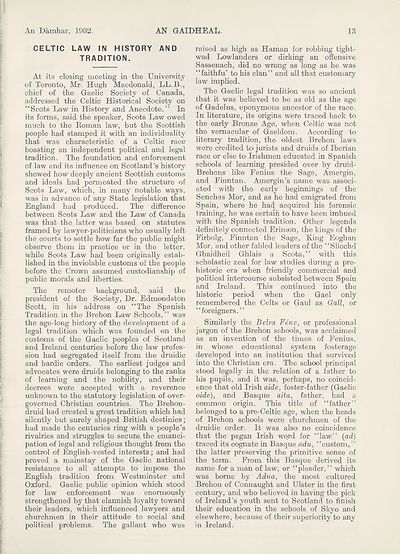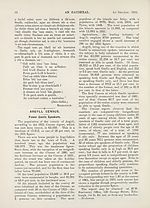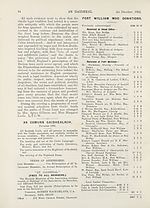An Comunn Gàidhealach Publications > Gaidheal > Volume 28, October 1932--September 1933
(25) Page 13
Download files
Complete book:
Individual page:
Thumbnail gallery: Grid view | List view

An Damhar, 1932.
AN GAIDHEAL.
13
CELTIC LAW IN HISTORY AND
TRADITION.
At its closing meeting in the University
of Toronto, Mr. Hugh Macdonald, LL.B.,
chief of the Gaelic Society of Canada,
addressed the Celtic Historical Society on
“Scots Law in History and Anecdote.’’ In
its forms, said the speaker, Scots Law owed
much to the Roman law, but the Scottish
people had stamped it with an individuality
that was characteristic of a Celtic race
boasting an independent political and legal
tradition. The foundation and enforcement
of law and its influence on Scotland’s history
showed how deeply ancient Scottish customs
and ideals had permeated the structure of
Scots Law, which, in many notable ways,
was in advance of any State legislation that
England had produced. The difference
between Scots Law and the Law of Canada
was that the latter was based on statutes
framed by lawyer-politicians who usually left
the courts to settle how far the public might
observe them in practice or in the letter,
while Scots Law had been originally estab¬
lished in the inviolable customs of the people
before the Crown assumed custodianship of
public morals and liberties.
The remoter background, said the
president of the Society, Dr. Edmondston
Scott, in his address on “The Spanish
Tradition in the Brehon Law Schools,’’ was
the age-long history of the development of a
legal tradition which was founded on the
customs of the Gaelic peoples of Scotland
and Ireland centuries before the law profes¬
sion had segregated itself from the druidic
and bardic orders. The earliest judges and
advocates were druids belonging to the ranks
of learning and the nobility, and their
decrees were accepted with a reverence
unknown to the statutory legislation of over-
governed Christian countries. The Brehon-
druid had created a great tradition which had
silently but surely shaped British destinies;
had made the centuries ring with a people’s
rivalries and struggles to secure, the emanci¬
pation of legal and religious thought from the
control of English-vested interests; and had
proved a mainstay of the Gaelic national
resistance to all attempts to impose the
English tradition fromi Westminster and
Oxford. Gaelic public opinion which stood
for law enforcement was enormously
strengthened by that clannish loyalty toward
their leaders, which influenced lawyers and
churchmen in their attitude to social and
political problems. The gallant who was
raised as high as Haman for robbing tight¬
wad Lowlanders or dirking an offensive
Sassenach, did no wrong as long as he was
“faithfu’ to his clan” and all that customary
law implied.
The Gaelic legal tradition was so ancient
that it was believed to be as old as the age
of Gadelus, eponymous ancestor of the race.
In literature, its origins were traced back to
the early Bronze Age, when Celtic was not
the vernacular of Gaeldom. According to
literary tradition, the oldest Brehon laws
were credited to jurists and druids of Iberian
race or else to Irishmen educated in Spanish
schools of learning presided over by druid-
Brehons like Fenius the Sage, Amergin,
and Finntan. Amergin’s name was associ¬
ated with the early beginnings of the
Senchas Mor, and as he had emigrated from
Spain, where he had acquired his forensic
training, he was certain to have been imbued
with the Spanish tradition. Other legends
definitely connected Erimon, the kings of the
Firbolg, Finntan the Sage, King Eoghan
Mbr, and other fabled leaders of the “Sliochd
Ghaidheil Ghlais a Scota,” with this
scholastic zeal for law studies during a pre¬
historic era when friendly commercial and
political intercourse subsisted between Spain
and Ireland. This continued into the
historic period when the Gael only
remembered the Celts or Gaul as Gall, or
“foreigners.”
Similarly the Belra Fene, or professional
jargon of the Brehon schools, was acclaimed
as an invention of the times of Fenius,
in whose educational system fosterage
developed into an institution that survived
into the Christian era. The school principal
stood legally in the relation of a father to
his pupils, and it was, perhaps, no coincid¬
ence that old Irish aide, foster-father (Gaelic
aide), and Basque aita, father, had a
common origin. This title of “father”
belonged to a pre-Celtic age, when the heads
of Brehon schools were churchmen of the
druidic order. It was also no coincidence
that the pagan Irish word for “law” (ad)
traced its cognate in Basque adu, “custom, ’ ’
the latter preserving the primitive sense of
the term. From this Basque derived its
name for a man of law, or “pleader,” which
was borne by Adna, the most cultured
Brehon of Connaught and Ulster in the first
century, and who believed in having the pick
of Ireland’s youth sent to Scotland to finish
their education in the schools of Skye and
elsewhere, because of their superiority to any
in Ireland.
AN GAIDHEAL.
13
CELTIC LAW IN HISTORY AND
TRADITION.
At its closing meeting in the University
of Toronto, Mr. Hugh Macdonald, LL.B.,
chief of the Gaelic Society of Canada,
addressed the Celtic Historical Society on
“Scots Law in History and Anecdote.’’ In
its forms, said the speaker, Scots Law owed
much to the Roman law, but the Scottish
people had stamped it with an individuality
that was characteristic of a Celtic race
boasting an independent political and legal
tradition. The foundation and enforcement
of law and its influence on Scotland’s history
showed how deeply ancient Scottish customs
and ideals had permeated the structure of
Scots Law, which, in many notable ways,
was in advance of any State legislation that
England had produced. The difference
between Scots Law and the Law of Canada
was that the latter was based on statutes
framed by lawyer-politicians who usually left
the courts to settle how far the public might
observe them in practice or in the letter,
while Scots Law had been originally estab¬
lished in the inviolable customs of the people
before the Crown assumed custodianship of
public morals and liberties.
The remoter background, said the
president of the Society, Dr. Edmondston
Scott, in his address on “The Spanish
Tradition in the Brehon Law Schools,’’ was
the age-long history of the development of a
legal tradition which was founded on the
customs of the Gaelic peoples of Scotland
and Ireland centuries before the law profes¬
sion had segregated itself from the druidic
and bardic orders. The earliest judges and
advocates were druids belonging to the ranks
of learning and the nobility, and their
decrees were accepted with a reverence
unknown to the statutory legislation of over-
governed Christian countries. The Brehon-
druid had created a great tradition which had
silently but surely shaped British destinies;
had made the centuries ring with a people’s
rivalries and struggles to secure, the emanci¬
pation of legal and religious thought from the
control of English-vested interests; and had
proved a mainstay of the Gaelic national
resistance to all attempts to impose the
English tradition fromi Westminster and
Oxford. Gaelic public opinion which stood
for law enforcement was enormously
strengthened by that clannish loyalty toward
their leaders, which influenced lawyers and
churchmen in their attitude to social and
political problems. The gallant who was
raised as high as Haman for robbing tight¬
wad Lowlanders or dirking an offensive
Sassenach, did no wrong as long as he was
“faithfu’ to his clan” and all that customary
law implied.
The Gaelic legal tradition was so ancient
that it was believed to be as old as the age
of Gadelus, eponymous ancestor of the race.
In literature, its origins were traced back to
the early Bronze Age, when Celtic was not
the vernacular of Gaeldom. According to
literary tradition, the oldest Brehon laws
were credited to jurists and druids of Iberian
race or else to Irishmen educated in Spanish
schools of learning presided over by druid-
Brehons like Fenius the Sage, Amergin,
and Finntan. Amergin’s name was associ¬
ated with the early beginnings of the
Senchas Mor, and as he had emigrated from
Spain, where he had acquired his forensic
training, he was certain to have been imbued
with the Spanish tradition. Other legends
definitely connected Erimon, the kings of the
Firbolg, Finntan the Sage, King Eoghan
Mbr, and other fabled leaders of the “Sliochd
Ghaidheil Ghlais a Scota,” with this
scholastic zeal for law studies during a pre¬
historic era when friendly commercial and
political intercourse subsisted between Spain
and Ireland. This continued into the
historic period when the Gael only
remembered the Celts or Gaul as Gall, or
“foreigners.”
Similarly the Belra Fene, or professional
jargon of the Brehon schools, was acclaimed
as an invention of the times of Fenius,
in whose educational system fosterage
developed into an institution that survived
into the Christian era. The school principal
stood legally in the relation of a father to
his pupils, and it was, perhaps, no coincid¬
ence that old Irish aide, foster-father (Gaelic
aide), and Basque aita, father, had a
common origin. This title of “father”
belonged to a pre-Celtic age, when the heads
of Brehon schools were churchmen of the
druidic order. It was also no coincidence
that the pagan Irish word for “law” (ad)
traced its cognate in Basque adu, “custom, ’ ’
the latter preserving the primitive sense of
the term. From this Basque derived its
name for a man of law, or “pleader,” which
was borne by Adna, the most cultured
Brehon of Connaught and Ulster in the first
century, and who believed in having the pick
of Ireland’s youth sent to Scotland to finish
their education in the schools of Skye and
elsewhere, because of their superiority to any
in Ireland.
Set display mode to:
![]() Universal Viewer |
Universal Viewer | ![]() Mirador |
Large image | Transcription
Mirador |
Large image | Transcription
| An Comunn Gàidhealach > An Comunn Gàidhealach Publications > Gaidheal > Volume 28, October 1932--September 1933 > (25) Page 13 |
|---|
| Permanent URL | https://digital.nls.uk/127131312 |
|---|
| Description | This contains items published by An Comunn, which are not specifically Mòd-related. It includes journals, annual reports and corporate documents, policy statements, educational resources and published plays and literature. It is arranged alphabetically by title. |
|---|
| Description | A collection of over 400 items published by An Comunn Gàidhealach, the organisation which promotes Gaelic language and culture and organises the Royal National Mòd. Dating from 1891 up to the present day, the collection includes journals and newspapers, annual reports, educational materials, national Mòd programmes, published Mòd literature and music. |
|---|---|
| Additional NLS resources: |
|

